You’ll find jewelers testing gold karats because federal law mandates accurate purity markings on all gold jewelry sold in the U.S. They’re protecting their professional reputation while ensuring you receive fair pricing based on actual gold content. Karat testing prevents fraud from increasingly sophisticated counterfeit pieces and builds customer trust through transparent evaluations. Whether you’re buying, selling, or getting jewelry appraised, accurate testing determines true value and protects both parties. There’s much more behind these essential practices.
Understanding Gold Purity Standards and Market Requirements
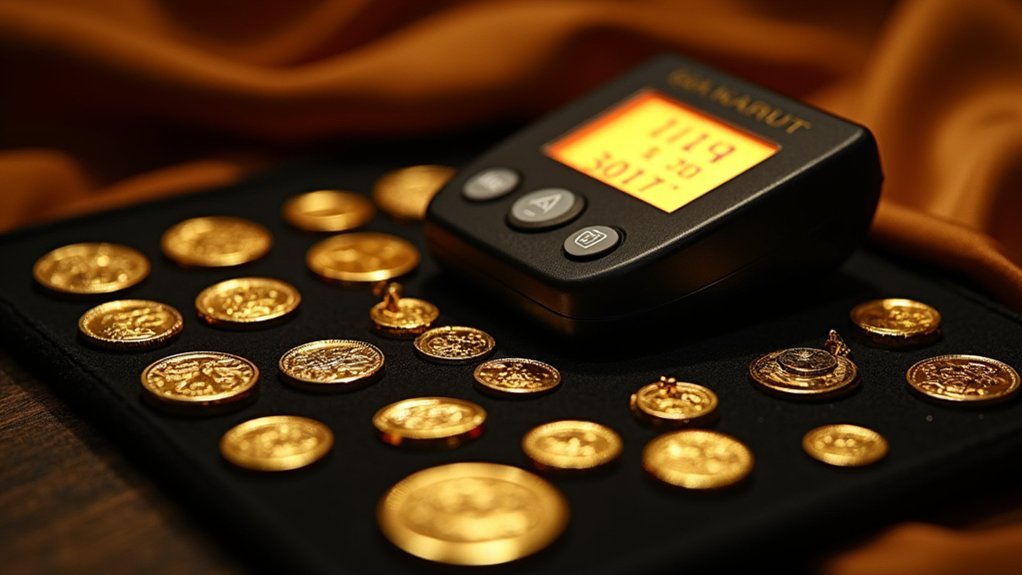
When you’re purchasing gold jewelry, jewelers must test the karat rating to verify the actual gold content and guarantee you’re getting what you pay for.
Gold purity standards use the 24-karat system, where pure gold equals 24 karats and lower numbers indicate alloy presence. You’ll find 18-karat gold contains 75% gold and 25% other metals, affecting both value and durability.
Gold Testing assures market compliance since gold purity is also expressed in parts per thousand. A “750” stamp means 75% gold content, essential for international trade standards.
With gold reaching approximately $1,900 per ounce, precise testing protects you from fraud and maintains business credibility.
Understanding these karat gold standards helps you make informed purchasing decisions while guaranteeing fair pricing in today’s fluctuating market.
Legal Obligations for Karat Marking and Accuracy
You’re legally required to stamp gold jewelry with accurate karat markings under federal law in the United States.
The Federal Trade Commission enforces these requirements to protect consumers from misleading gold purity claims.
You’ll also need to comply with varying regional standards, as many states have additional regulations governing precious metal sales beyond federal mandates.
U.S. Stamping Requirements
Although gold’s inherent value speaks for itself, federal law doesn’t leave karat marking to chance—it mandates that all gold jewelry sold in the United States must display clear karat stamps indicating the item’s gold content.
These regulations require specific markings like “10k,” “14k,” or “18k” that correspond to the gold’s purity level on the 24-karat scale, where 24k represents pure gold.
You’ll find that jewelers must comply with strict accuracy standards when applying these stamps. Misrepresenting karat content carries serious legal consequences and damages consumer trust.
This federal oversight guarantees you’re getting exactly what you’re paying for, maintaining market integrity and protecting your investment’s resale value in the competitive jewelry marketplace.
Regional Marking Standards
Gold marking standards extend far beyond U.S. borders, as different countries have established their own legal frameworks governing how jewelry purity must be displayed. When you’re testing gold, you’ll encounter various regional systems that determine how purity of gold gets marked on jewelry pieces.
| Region | Marking System | Example | U.S. Equivalent |
|---|---|---|---|
| Europe | Parts per thousand | 750 | 18k |
| U.K. | Hallmarking | 375 | 9k |
| Asia | Mixed standards | 916 | 22k |
You’ll find that some countries mandate purity stamps on all gold jewelry, while others don’t require marking at all. These varying requirements mean jewelers must adapt their testing gold practices to meet local compliance standards, ensuring accurate representation of gold jewelry purity across different markets.
Protecting Customer Trust Through Accurate Valuations
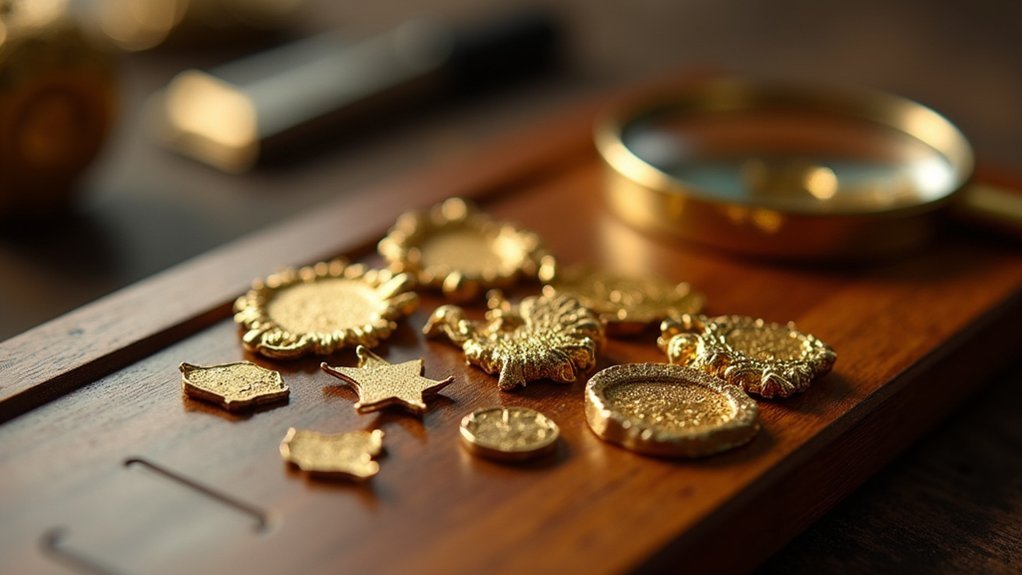
When customers bring their precious gold items to your shop, they’re placing their trust in your ability to provide accurate and fair valuations. Your testing methods directly impact this relationship. By utilizing scientifically proven techniques like X-ray fluorescence and acid testing, you demonstrate professional competency that customers recognize and value.
Establishing transparent testing processes enhances customer confidence in your assessments. When you clearly explain how you determine gold purity, customers understand they’re receiving reliable evaluations based on objective data rather than guesswork.
Consistent accuracy in your testing protects customers from unfair pricing while reinforcing your reputation in a competitive market. Each precise valuation you provide builds lasting trust, encouraging repeat business and referrals that sustain your jewelry business long-term.
Preventing Fraud and Counterfeit Gold Detection
Because counterfeit gold items flood the market with increasing sophistication, your ability to detect fraudulent pieces becomes essential for protecting your business and customers.
You’ll encounter deceptive practices where criminals plate base metals with thin gold layers, creating jewelry that appears genuine but lacks true value. Acid testing helps you expose these counterfeits by revealing the underlying metal composition when the gold coating reacts differently than solid gold.
Your XRF testing equipment provides even more precise detection, measuring the exact purity levels without damaging the piece.
These testing methods protect you from significant financial losses while maintaining your reputation. When you accurately identify fake gold, you’re safeguarding both your inventory investments and customer relationships, ensuring every transaction reflects honest valuations.
Determining Fair Purchase and Selling Prices

When you’re buying or selling gold, testing the karat content guarantees you’ll receive a fair price based on the actual gold percentage in your piece.
Without proper testing, you risk overpaying for lower-quality gold or underselling valuable high-karat items.
Accurate karat assessment eliminates pricing disputes by establishing the true market value through objective measurement rather than guesswork.
Accurate Market Value Assessment
Market fluctuations in gold prices make accurate karat testing essential for determining fair purchase and selling prices. When you bring a gold sample to a jeweler, they’ll use a professional testing kit to establish its exact purity level.
This precise assessment directly correlates to accurate market value, ensuring you receive proper compensation based on current gold rates of approximately $1,900 per ounce.
Without proper testing, you risk significant financial losses. A piece assumed to be 18-karat gold might actually contain only 14-karat purity, dramatically affecting its worth.
Professional jewelers rely on advanced methods like X-ray fluorescence testing to provide non-destructive, reliable analysis. This scientific approach eliminates guesswork and establishes trust between buyers and sellers, guaranteeing transactions reflect true gold content and current market conditions.
Preventing Pricing Disputes
Pricing disputes between jewelers and customers often stem from inaccurate gold purity assessments that lead to unfair valuations. When you’re selling gold jewelry, you want assurance that you’ll receive payment reflecting your item’s true worth. Without proper testing methods like the acid test, assumptions about karat ratings can create significant disagreements over pricing.
| Karat Rating | Gold Purity | Market Value Impact |
|---|---|---|
| 24K | 100% | Highest price |
| 18K | 75% | 25% less than 24K |
| 14K | 58.3% | 41.7% less than 24K |
| 10K | 41.7% | 58.3% less than 24K |
| Plated | <5% | Minimal value |
Accurate testing eliminates guesswork, establishing transparent pricing based on actual gold content. This protects both parties—you’ll receive fair compensation while jewelers maintain their reputation through honest assessments of the value of gold.
Insurance and Appraisal Documentation Needs
Although gold testing might seem like a routine procedure, it becomes absolutely critical when you’re dealing with insurance coverage and appraisal documentation.
Insurance providers require precise documentation of your jewelry’s karat rating to validate coverage and process claims effectively. Without accurate appraisal records showing verified gold purity, you’ll face potential disputes if you need to file a claim.
Proper testing establishes the true market value of your pieces, protecting both you and your jeweler from financial losses.
Insurance policies often mandate specific karat documentation, making reliable testing non-negotiable for coverage. When jewelers provide transparent, accurate assessments, they create trusted documentation that satisfies insurance requirements while fostering confidence between all parties involved in the appraisal process.
Quality Control in Jewelry Manufacturing
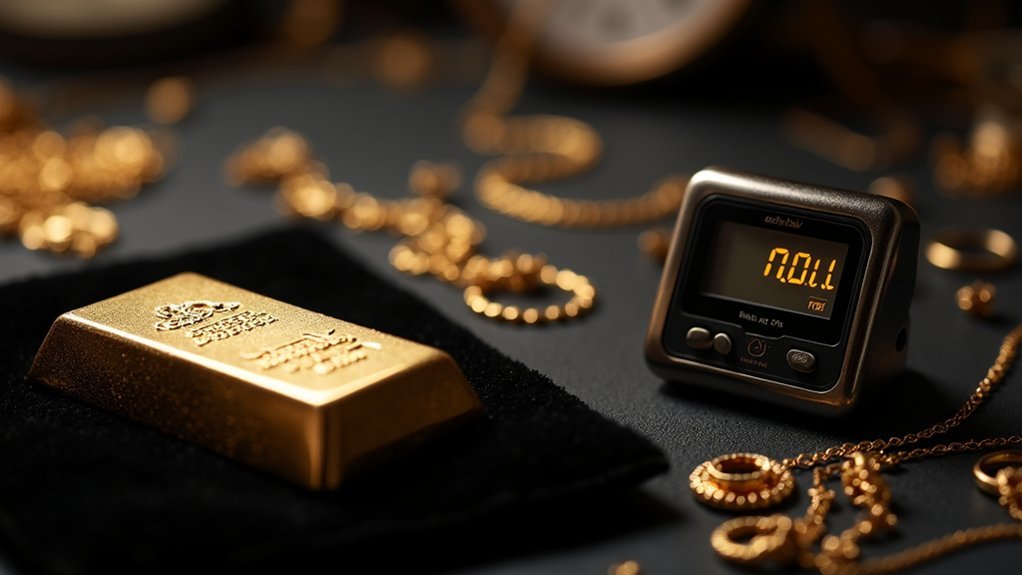
You’ll need to test gold karats consistently throughout your manufacturing process to meet industry standards and maintain product quality.
Testing guarantees your alloy compositions match the specifications you’ve promised customers, whether you’re producing 14k, 18k, or 24k pieces.
This verification process prevents costly errors and protects your reputation by assuring each piece contains the exact gold content advertised.
Manufacturing Standards Compliance
When jewelers manufacture gold pieces, they must adhere to strict industry standards that dictate precise karat specifications for each product category. You’ll find that compliance testing becomes essential to avoid regulatory fines and sanctions imposed by governing bodies. Regular purity verification guarantees your products meet established benchmarks.
| Standard Type | Karat Requirement | Testing Frequency |
|---|---|---|
| Fine Jewelry | 14K-18K minimum | Every batch |
| Luxury Pieces | 18K-22K required | Per item |
| Commercial | 10K-14K standard | Daily sampling |
Your quality control protocols must include systematic karat testing to prevent fraud and maintain authenticity claims. This rigorous approach protects your brand reputation while guaranteeing customer trust. You’re not just meeting manufacturing requirements—you’re establishing credibility in a market where purity standards directly impact consumer confidence and business success.
Alloy Composition Verification
Beyond meeting basic manufacturing standards, precise alloy composition verification forms the backbone of quality control in jewelry production.
You’ll find that jewelers can’t rely on visual inspection alone when determining gold purity. The karat rating directly affects your jewelry’s color, durability, and market value, making accurate testing vital.
When you’re purchasing precious metals, verification protects you from counterfeit items. Jewelers use acid testing and X-ray fluorescence methods to analyze alloy composition without damaging pieces. This process guarantees you’re getting exactly what you’re paying for.
- Acid testing reveals gold content through chemical reactions
- Color variations indicate different alloy percentages and metal combinations
- Durability testing confirms structural integrity for daily wear
- Value authentication prevents financial loss from misrepresented items
- Brand protection maintains jeweler reputation and customer trust
Identifying Gold-Filled vs. Solid Gold Pieces
Two primary types of gold jewelry exist in the market: gold-filled and solid gold pieces, each requiring different testing approaches to accurately determine their value and authenticity.
Accurate identification of gold-filled versus solid gold jewelry requires specialized testing methods due to their fundamentally different construction and composition.
When you’re examining gold-filled jewelry, you’ll notice it contains a base metal core with a gold layer that’s much thinner than solid gold. This construction makes gold-filled pieces susceptible to wear over time, eventually revealing the underlying metal.
You’ll find that acid tests reveal significant differences between these types. When acid contacts gold-filled items, it reacts with the base metal beneath the surface layer, while solid gold remains unaffected.
Jewelers also use density tests and X-ray fluorescence testing to distinguish between them, since solid gold has higher density and unique elemental composition compared to gold-filled pieces.
Compliance With Industry Standards and Regulations
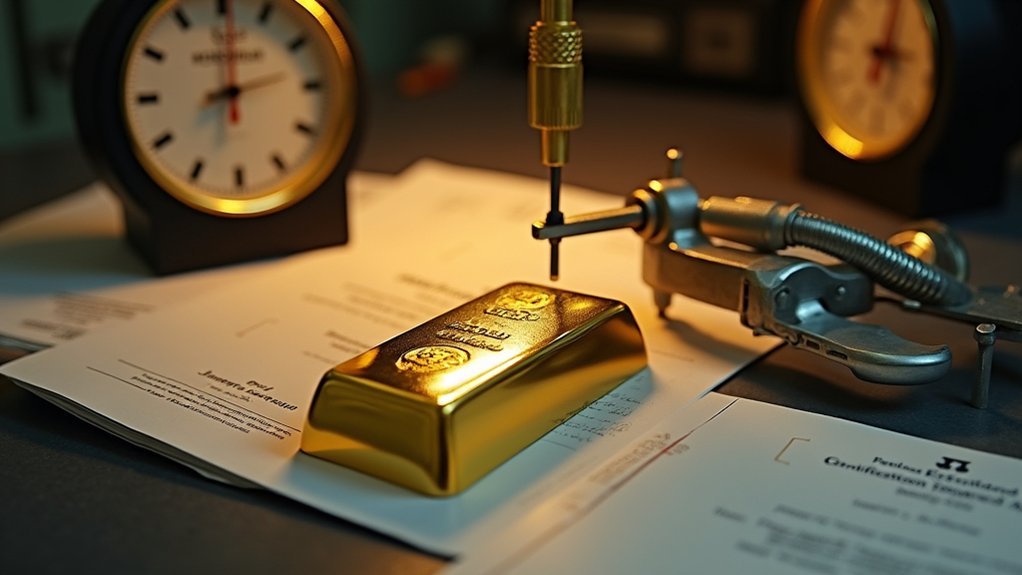
Although jewelers possess various motivations for testing gold, compliance with industry standards and regulations stands as one of the most critical drivers behind their testing practices.
You’ll find that regulations mandate accurate representation of gold content to protect consumers and maintain market integrity. When you display karat marks on gold items, testing becomes essential to verify that stated purity matches actual content.
Key compliance requirements include:
- Federal Trade Commission guidelines that prohibit deceptive marketing practices in the U.S.
- ISO 8653 international standards defining methods for testing and reporting gold content
- Karat marking regulations requiring verification of displayed purity levels
- Consumer protection laws mandating honest representation of gold content
- Industry consistency standards promoting uniformity across global markets
Your compliance with these regulations enhances reputation while fostering consumer trust.
Managing Business Risk and Financial Liability
When you’re dealing with precious metals worth nearly $1,900 per ounce, accurate karat testing becomes your primary defense against devastating financial losses. Every time you test gold, you’re protecting yourself from costly mistakes that could destroy your reputation and bottom line.
| Risk Factor | Without Testing | With Proper Testing |
|---|---|---|
| Counterfeit Detection | High exposure to fake gold | Protected against fraud |
| Customer Disputes | Frequent returns/refunds | Confident transactions |
| Legal Issues | Misrepresentation lawsuits | Compliant operations |
When you determine the value through rigorous XRF or acid testing methods, you’re minimizing financial liability while building customer trust. This systematic approach prevents the nightmare scenario of discovering you’ve overpaid for low-quality gold or sold genuine pieces at incorrect prices.
Professional Reputation and Credibility Maintenance
Beyond protecting your financial interests, accurate gold testing serves as the cornerstone of your professional standing in the jewelry industry. Your credibility depends on providing transparent, trustworthy valuations that clients can rely on. When you consistently deliver accurate assessments, you demonstrate expertise that sets you apart from competitors.
Professional reputation hinges on your commitment to quality testing methods like X-ray fluorescence (XRF), which guarantees precise results. This dedication builds customer trust and generates positive referrals that sustain your business long-term.
- Accurate testing prevents legal issues from misrepresenting gold quality
- Reliable testing methods enhance transparency with clients
- Consistent quality standards lead to repeat business
- Ethical practices strengthen your industry standing
- Knowledgeable assessments generate positive word-of-mouth referrals
Inventory Management and Proper Categorization
Effective inventory management starts with precise gold karat testing, as this fundamental process enables you to categorize your stock accurately and maximize your profitability.
When you test gold karats, you’re differentiating between varying purities, which allows you to price items appropriately based on their actual material value. This accurate categorization prevents costly mistakes that could impact your bottom line.
Proper inventory management through karat testing helps you maintain ideal stock levels while ensuring compliance with legal requirements for karat markings.
You’ll minimize losses from misclassified items and provide customers with reliable information about product quality and authenticity.
Estate and Antique Jewelry Authentication
Gold karat testing becomes particularly valuable when you’re working with estate and antique jewelry, where authenticity and accurate valuation are paramount.
These pieces often come without documentation, making precise gold purity verification crucial for determining their true worth and historical significance.
When you’re authenticating antique jewelry, you’ll need reliable testing methods to uncover counterfeit pieces that lack proper karat markings.
Historical production standards varied considerably, so you can’t rely solely on visual inspection or existing stamps.
Modern testing techniques help you provide accurate assessments:
- Acid testing reveals gold content through chemical reactions
- X-ray fluorescence provides non-destructive purity analysis
- Density testing confirms metal composition without damage
- Karat marking verification validates authenticity claims
- Historical standard comparison guarantees period-appropriate purity levels
Educational Value for Customer Awareness
How can jewelers build stronger relationships with their customers while demonstrating expertise? By educating you about gold karat testing, jewelers transform routine transactions into valuable learning experiences.
When you understand the difference between 24-karat pure gold and lower karat ratings with alloys, you’ll make more informed purchasing decisions.
Jewelers who explain testing methods like acid testing and X-ray fluorescence demonstrate their commitment to transparency. This precious metal education helps you recognize authentic quality and understand how purity directly impacts pricing.
When you grasp why testing matters, you’ll appreciate fair valuations and trust your jeweler’s assessments.
This educational approach empowers you to evaluate jewelry confidently, whether you’re buying new pieces or selling existing ones. You’ll understand how karat ratings affect value in today’s fluctuating market.
Frequently Asked Questions
Can a Jeweler Tell What Karat Gold Is?
Yes, you can determine gold karat through several methods. You’ll find stamps indicating purity, use acid tests, employ touchstone methods, rely on visual inspection, or utilize advanced X-ray fluorescence technology for precise measurements.
Why Is 22 Carat Gold Not Used in Diamond Jewellery?
You won’t find 22 carat gold in diamond jewelry because it’s too soft and malleable. It scratches easily, bends under pressure, and can’t securely hold diamonds in their settings during everyday wear.
Why Is Gold Measured in Carats?
You’ll find gold measured in karats because this system standardizes purity measurement. Each karat represents one twenty-fourth of pure gold content, so you can easily compare different gold alloys’ quality and value.
Can a Ring Be Real Gold if It Is Not Stamped?
Yes, you can own a real gold ring without stamps. Many authentic pieces, especially vintage or handmade jewelry, lack markings. You’ll need professional testing to verify authenticity and karat content.
In Summary
You’ll find that testing gold karats isn’t just a formality—it’s essential for your business success. You’re protecting yourself legally, maintaining customer trust, and ensuring fair pricing. When you accurately test and verify gold purity, you’re building credibility while preventing costly mistakes from fraud or misidentification. Whether you’re buying estate pieces or selling new jewelry, proper karat testing keeps your reputation intact and your customers confident in their purchases.


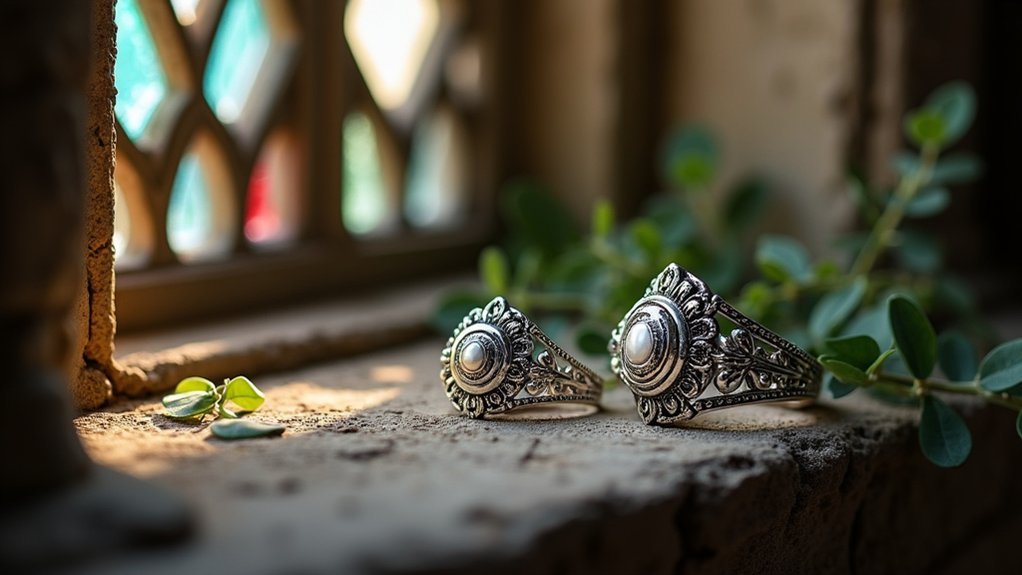

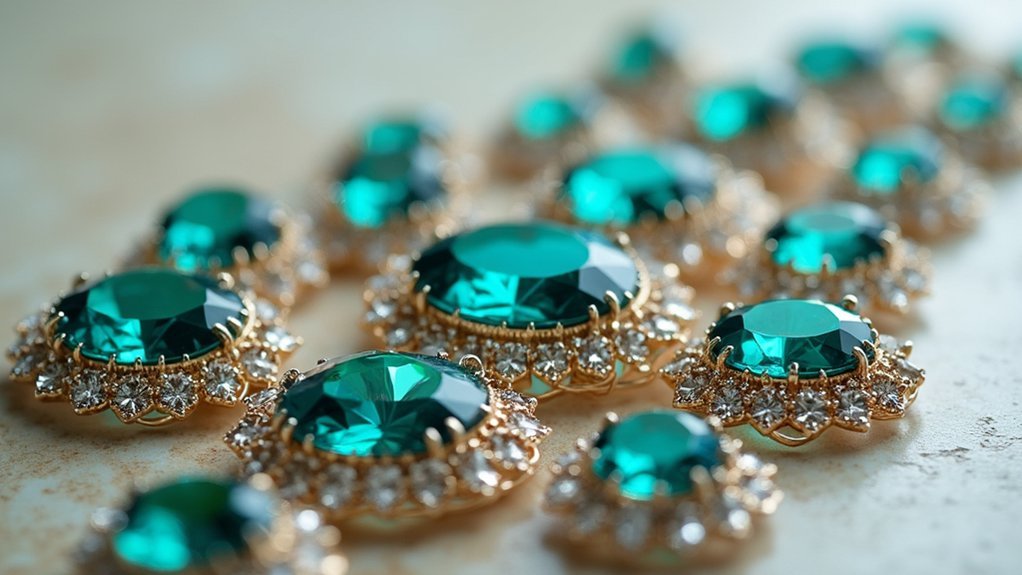
Leave a Reply